How to choose a kitchen wall corner cabinet?

For a comfortable and efficient use of space in the kitchen, cabinets are installed. They make it possible to properly store food, kitchen utensils, large and small household appliances. On the modern market there is a wide selection and assortment of similar furniture for the kitchen, you can pick it up for every taste and color.
In this article, we will talk in more detail about the wall-mounted corner cabinets, what technical characteristics they have, how to choose the right design.
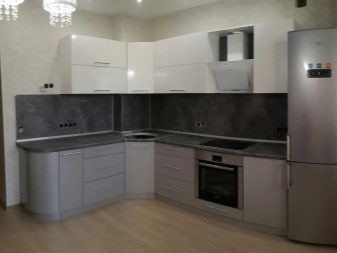
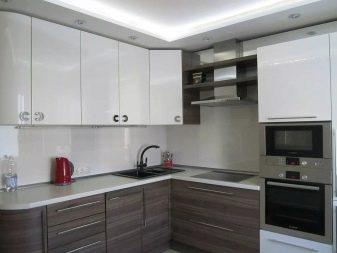

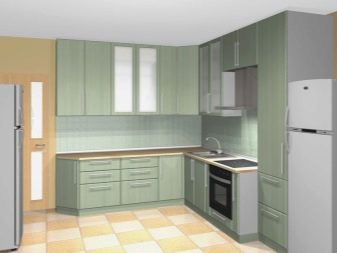
Specifications
In appearance, the suspended top cabinet is a low cabinet, which is located in the corner of the room. and is an integral part of the corner kitchen set. It can be purchased separately or as a set.
In almost every kitchen, a corner cabinet is installed and this is due to a number of design features and advantages, which include:
- spaciousness;
- compact size - in such furniture you can store both food and dishes and household appliances;
- a wide selection and range of design solutions;
- combined with all types of kitchen layouts and interior design;
- makes it possible to competently use and arrange the corners of the room.
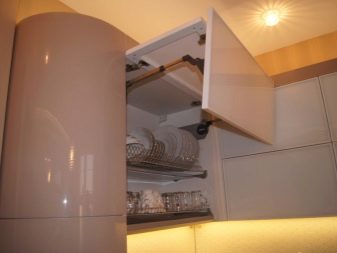
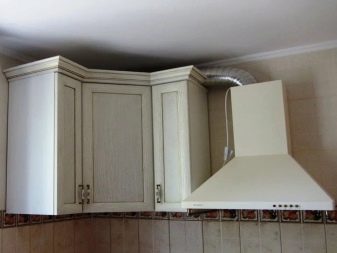
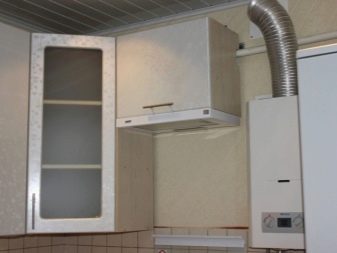

Views
It is safe to say that furniture manufacturers have tried their best and have managed to come up with and implement the most diverse forms of this hinged module. He might be:
- butt;
- trapezoidal;
- L-shaped.

Butt module
This type of cabinet is also often called straight. It has a classic rectangular shape. Usually installed to the front of another headset element.
The docking cabinet can be mounted near the corner sink, the sinks are its great advantage. As for the disadvantages, it is worth noting the fact that its blank wall is inaccessible.

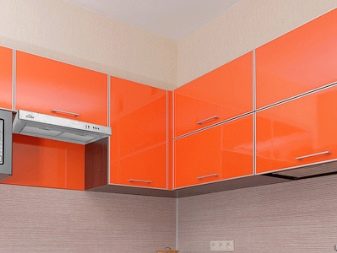

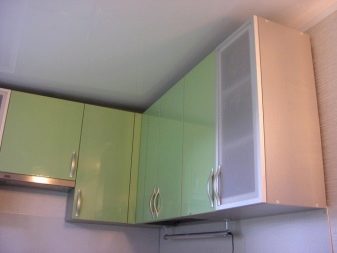
Trapezoidal module
This type of corner cabinet is characterized by the presence of a beveled corner. Its functionality is unlimited:
- other furniture elements can be attached to the cabinet;
- if the module is located near the sink and sink, it can store both useful little things and household chemicals, dishwashing sponges and brushes.
The dimensions of such a module are quite large, and if the kitchen area is limited, then it is irrational to use it - it will only clutter up the space.
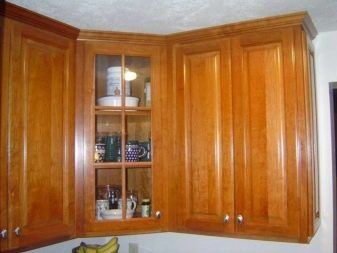
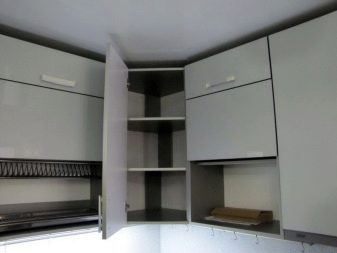
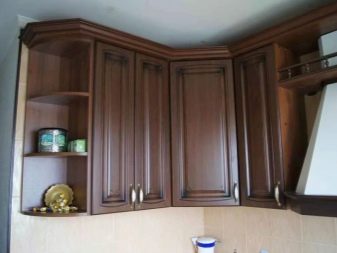
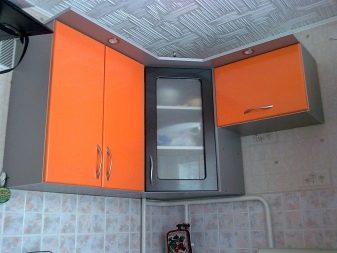
L-shaped module
This is a cabinet that follows the corner of the wall exactly. Such furniture has a number of advantages:
- even an incomplete opening of the door of the structure provides full access to the space inside;
- the presence of a fairly wide and varied selection of fittings, which makes it possible to implement any design solution and make the module a highlight of the kitchen.
Such a hinged corner cabinet is the most popular among consumers. But if we talk about the shortcomings, then it is worth mentioning that the module has limited usable internal space.

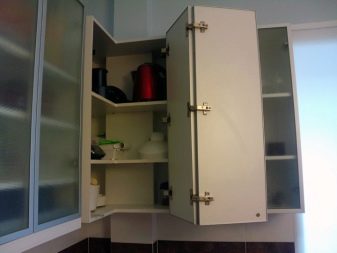
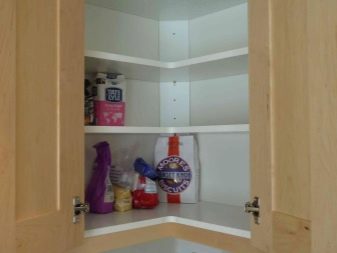
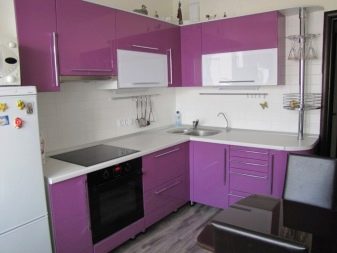
Functional features
The corner module is in demand among the consumer due to its wide functionality. Based on the functionality, it can be:
- universal - food, kitchen utensils, household chemicals and other items that you usually want to hide are stored in such a cabinet;
- dishware - in such a module, dishes are stored and dried, the place of its installation is the wall above the sink;
- for built-in technology - you can install a hood, a compact dishwasher.
In the modern market, you can find such models, the functionality of which is not wide enough, and they are more often used for decoration. In such a cabinet you can store decorative elements, spices, vases, flower arrangements.
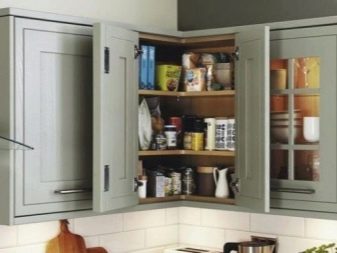
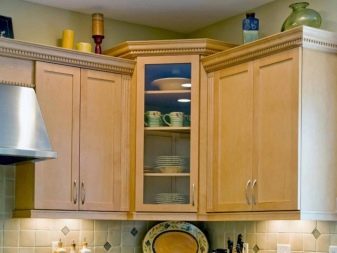
Opening systems
Corner kitchen wall cabinets can differ not only in appearance, design, functionality, but also in the door opening system. There are various options for the opening system.
- Swing / folding - the advantages of such a system include ease of installation, ease of use and affordable cost. Among the disadvantages, it is worth noting that it is not suitable for a small kitchen.
- Sliding - these are compartment doors that are characterized by their compactness. But for such an opening system, additional guiding elements are needed, and the door does not close tightly enough.
- Foldable - this system provides that the doors will open and close like a book or an accordion, they are very stylish and compact. But, despite the modern and fashionable design, such a door will not last long.
Experts say that when choosing an opening system, it is better to give preference to the more expensive option. A spring or gas lift lift door is ideal. This design is characterized by smooth movement, noiselessness and providing the most convenient access to the contents of the module.
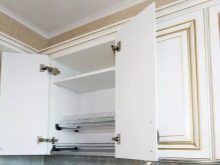


Manufacturing material
The range of materials from which hinged corner cabinets are made today is quite diverse. These can be the following options:
- natural wood - in most cases, oak and ash wood is used;
- Chipboard and MDF;
- TSP - thermo-structured surface, which is made of chipboard and MDF;
- multiplex - the most modern material for the manufacture of kitchen furniture, which is a thin layer of wood and has a number of advantages over its counterparts, but it is quite expensive.
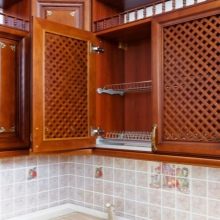
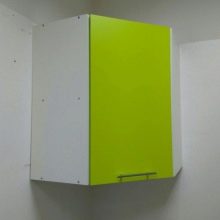
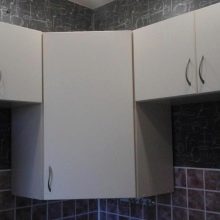
How to fix the structure?
In practice, several methods of attaching a wall-mounted corner cabinet are used.
Installation can be carried out using hinges - dowels, nails and screws are required for work. On the back wall of the module there are special hinges on which it is suspended.
Install such furniture on a mounting rail. To do this, you need to purchase a mounting rail, on which the module will ultimately be fixed. This fastening method is only possible if the walls in the kitchen are made of plasterboard. This is necessary so that the load is evenly distributed.
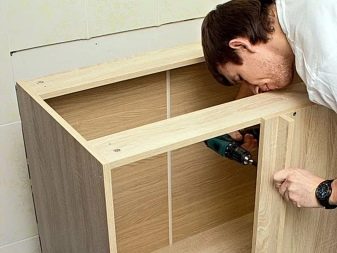
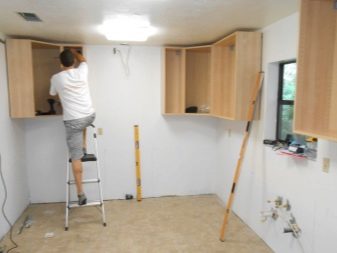
How do you choose?
It is important for every housewife that the wardrobe lasts a long time, and, in addition, is functional and beautiful.
To decide on the choice of a hinged corner module, you need to take into account the following nuances:
- dimensions of the kitchen;
- the dimensions of the structure itself;
- type of construction;
- functionality and dimensions of the useful area of the cabinet;
- door opening system;
- material of manufacture;
- installation method;
- the design of the cabinet - so that it fits well and fits into the interior and the general mood of the room;
- manufacturer - it is better to give preference to a well-known brand that guarantees the quality, reliability and safety of its product.
If you wish, you can use the services of specialists to make a custom-made kitchen wall-mounted corner cabinet.


The video shows the technology for assembling a corner cabinet.








